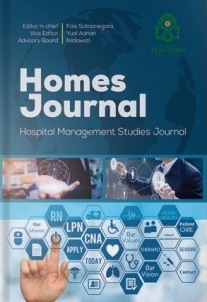EFFECTIVENESS OF LEVEL 1 PROGRESSIVE MOBILIZATION ON DECREASED INTRACRANIAL ADAPTIVE CAPACITY IN HEMORRHAGIC STROKE CASES
Abstract
The prevalence of stroke diagnosed by doctors in Indonesia in 2018 was aged ≥ 15 years (10.9%) or an estimated 2,120,362 people. South Sulawesi has the highest prevalence of stroke based on diagnosis and symptoms reported by health workers. Hemorrhagic stroke is a stroke caused by rupture of a blood vessel in the brain, which results in downstream ischemia and hypoxia. One of the interventions that can be done to overcome the decrease in intracranial adaptive capacity is to perform stage progressive mobilization. The purpose of the case study was to carry out nursing care in hemorrhagic stroke patients with reduced intracranial adaptive capacity using level 1 progressive mobilization interventions in the ICU RSUP. Dr. Wahidin Sudirohusodo Makassar. The method used is a case study with data collection techniques through observation, interviews, physical examination and documentation. The results showed that level 1 progressive mobilization once a day for 3 days before and after the intervention found that level 1 progressive mobilization could be used to stabilize blood pressure, level of consciousness and oxygen saturation. The conclusion based on the results show that the implementation of level 1 progressive mobilization showed that on the first day to the third day of implementation there was an increasing in hemodynamic state, in this case the blood pressure improved, oxygen saturation increased and the level of consciousness increased. This indicates that level 1 progressive mobilization is effective in patients who have problems with decreased intracranial adaptive capacity
References
Organization WH. Annual Report 2021. 2021;0(0):260.
Kemenkes RI. Profil Kesehatan Indonesia. Health Statistics. 2019. 207 p.
Nurhikmah N, Sudarman S, Aswadi A. Hubungan Pola Makan Dan Perilaku Dengan Kejadian Stroke di RSUD Lanto Daeng Pasewang Kabupaten Jeneponto. Al GIZZAI PUBLIC Heal Nutr J. 2021;1(2):111–23.
Astuti et al. Mobilisasi Progresif Level I Menstabilkan Tekanan Darah dan Saturasi Oksigen Pasien Stroke. Kaji Ilm Probl Kesehat. 2022;7(October):599–606.
Tim Pokja SDKI DPP PPNI. Standar Diagnosis Keperawatan Indonesia. Jakarta Selatan; 2016.
Hartoyo M, Shobirun S, Budiyati B, Rachmilia R. Pengaruh Mobilisasi Progresif Level I Terhadap Tekanan Darah Dan Saturasi Oksigen Pasien Kritis Dengan Penurunan Kesadaran. J Perawat Indones. 2017;1(1):1.
Agustin WR, Suparmanto G, Safitri W. PENGARUH MOBILISASI PROGRESIF TERHADAP STATUS HEMODINAMIK PADA PASIEN KRITIS DI INTENSIVE CARE UNIT. J Heal Res. 2020;3(1):20–7.
Mustikarani A, Mustofa A. Peningkatan Saturasi Oksigen Pada Pasien Stroke melalui Pemberian Posisi Head Up. Ners Muda. 2020;1(2):114.
Mobiliu S, Tomayahu M. Effect of Progressive Mobilization on Blood Pressure Changes in Stroke Patients in Icu Room. Jambura J Heal Sci Res. 2021;3(2):195–205.
Syaikh A bin MA. Lulabut Tafsir Min Katsir Pentahqiq/Peneliti. Jakarta: Mu-assasah Daar al-Hilaal Kairo; 2015.
KEMENAG. Al-Quran KEMENAG. 2022.


